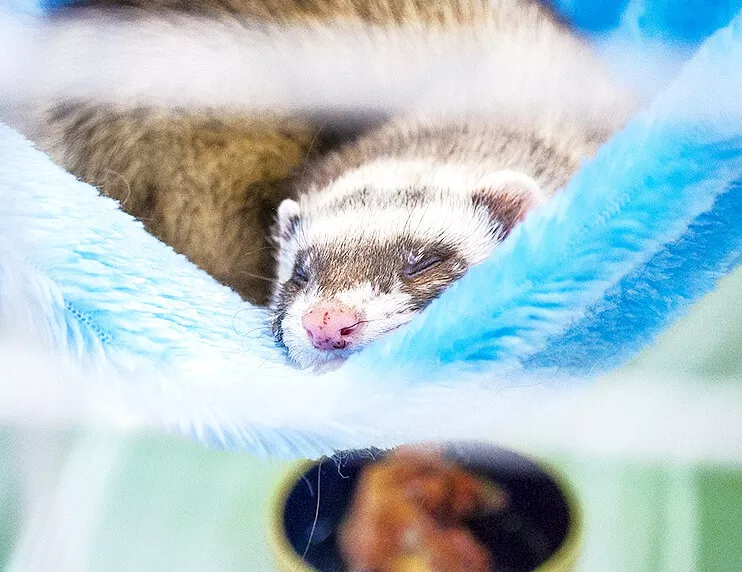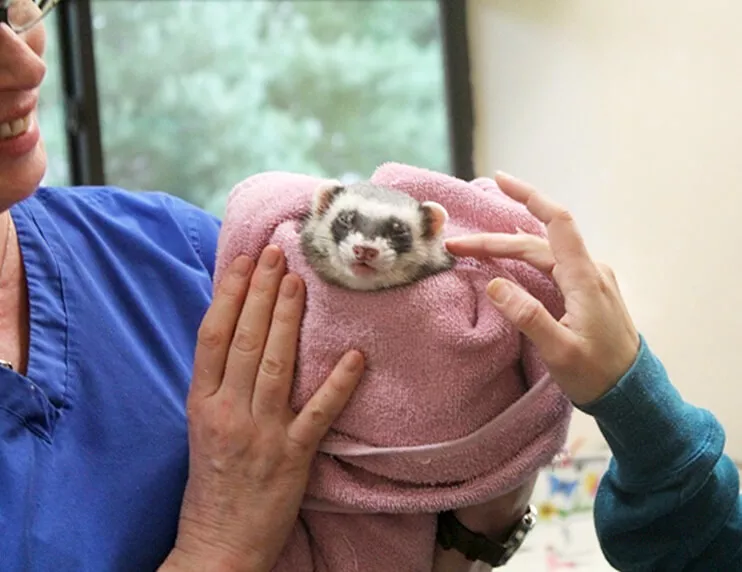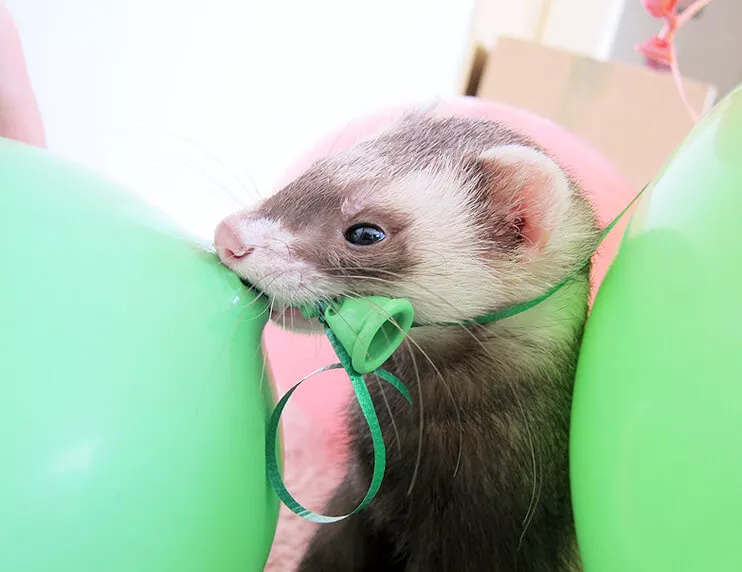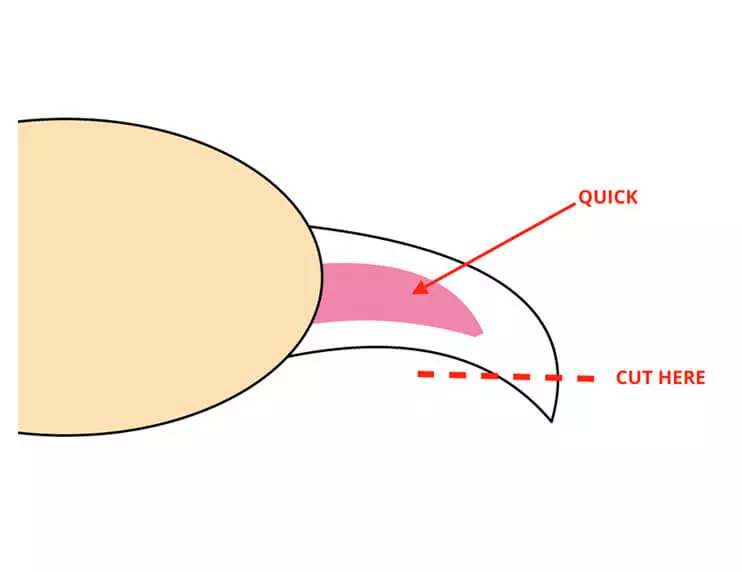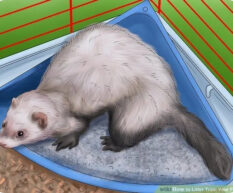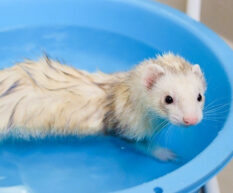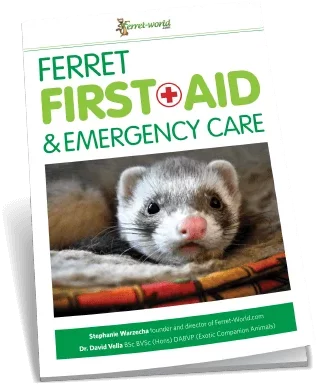Ferret News
New Ferret Checklist
By Courtney Stoker

Getting a new ferret is exciting and fun, but there are a lot of things you need to do to be completely ready for your new fuzzy. Whether it’s your first ferret or you’re adding to a growing business, this checklist will keep you on track!
This article originally appeared in Dook Dook Ferret Magazine (Issue 7). To receive 6 new Dook Dook Ferret Magazines per year + get access to other bonuses then join the Ferret-World Membership.
Housing & Recreation
Even if your ferrets are free roaming, you’ll want someplace to put them for when you’re cleaning, entertaining, or otherwise need them to not be underfoot. This can be a cage, pen, or even just a room with a door they can’t wriggle under.
If you’re adding a new ferret, make sure your current housing is big enough and add extensions or replace the enclosure if not.
- Buy, salvage, or make bedding options–the more, the better
Ferrets love to have options, so make sure you have plenty of different kinds (sleep sacks, pet beds, hammocks, etc.) throughout their living area
- Make sure there’s at least one place where the ferret can be in complete darkness
Ferrets need a quiet, dark place to retreat. There’s evidence that too much light can negatively affect your ferret, so make sure they can get to a place where it’s completely dark.
- Buy at least one large, heavy water bowl
While you can also give your ferret a drip bottle of water, they appreciate having an open bowl that they can drink from. You want it to be heavy so they can’t tip it over! Alternatively, you can get a bowl that attaches to your cage bars so it can’t be tipped over.
- Buy at least one small, heavy food bowl
Alternatively, you can get a bowl that attaches to your cage bars so it can’t be tipped over.
- Buy or make at least one high-backed litter box per ferret + dust-free/low-dust litter
Clumping litters, particularly those made for cats, contain a lot of dust that can get into your ferret’s lungs. Pick a litter that says it is 99% or 100% dust free.
- Buy or make toys
Ferrets are intelligent and thus easily bored! Make sure your ferret has plenty to keep her entertained both in and out of her cage.
Avoid anything made of soft rubber or any other material that your ferret could chew into pieces and accidentally (or purposefully) ingest.
Health
- Make a ferret first aid kit
Your ferret first aid kit should include:
- Vet and vaccination records
- The contact information for your vet
- Local animal poison control phone numbers
United States:
| ASPCA Animal Poison Control ($65) | (888) 426-4435 |
| Kansas State University Veterinary Teaching Hospital (Free) | (785) 532-5679 |
Canada and the United States:
| Pet Poison Helpline ($59 USD) | (855) 764-7661 |
United Kingdom:
| Animal Poison Line | 01202 509 000 |
- Your local emergency vet’s phone number
- Your ferret’s favorite treats to distract them
- A healthy, high-quality hairball remedy/laxative
- Adhesive bandage tape, gauze pads, and gauze wrap to stabilize injuries
- Children’s Benadryl for coughs or allergic reactions (talk to your vet about the appropriate dose for your ferrets)
- Antibiotic ointment and hydrogen peroxide to sterilize wounds
- Chemically-activated heating and cooling pads (and a towel to wrap them in) for sick or overheated ferrets
- Rubber or latex gloves to prevent infection
- Kaopectate/Pepto Bismol for upset stomach (talk to your vet about the appropriate dose for your ferrets)
- Cotton balls and swabs
- Pedialyte for dehydration or ferrets who are not eating well
- Tweezers
- Bitter Apple or some other product that discourages licking after surgery or injury
- Meat-based baby food with no vegetable content for ferrets who are not eating well. This is not the best food replacement for your ferret, but a good option when you cannot access your vet immediately.
Do NOT give your ferret medication, including Benadryl or Pepto Bismol, without talking to your vet first.
- Take your ferret to the vet for a checkup and vaccinations, if necessary
- Ask your vet about flea and heartworm prevention and put them in your first aid kit
Depending on where you live, you may need to regularly treat your ferrets to prevent fleas and/or heartworm.
Photo by Mariposa Veterinary Wellness Center
Food
- Research and find a source for high-quality ferret food with plenty of meat protein and fat
If you’re feeding your ferret a whole prey or raw diet, research safety measures and what nutrients your ferret needs so you can make sure she receives the variety of foods she needs.
Safety
- Purchase a sturdy carrier, leash, and harness
Even if you don’t plan to take your ferret out often, you need to make sure you’re prepared for an emergency. If you ever need to evacuate your home, you need to be able to travel with your ferret and safely let them outside or in a shelter without their escaping.
- Get your ferret microchipped and/or purchase a collar and ID tag
- Ferret-proof your home
Make sure there are no small spaces your ferrets can escape to, whether it’s behind the fridge, under the cabinets, or even inside appliances. Block anywhere that can be dangerous to your ferrets and invest in a good playpen or gate to keep your fuzzies safely contained. Make sure your ferrets can’t get into dryer vents, air conditioning ducts, or heating ducts.
Watch your ferrets closely and, if necessary, cover wires with PVC piping, install baby proofing cabinet latches, and insert outlet covers. Keep cleaning supplies out of the way, where ferrets cannot access them.
If you have a reclining or rocking chair, the safest thing is to either get rid of it or move it to where the ferret will never be allowed. Both of these can easily kill or injure ferrets.
Make sure your ferret can’t get access to things they may swallow, like balloons, without supervision. Photo by Roy Maloon
Hygiene
- Purchase a nail trimmer
Your ferret’s nails will need to be trimmed regularly, typically every 1-2 weeks. Cut the nail parallel to the floor and make sure you don’t cut the quick, the vein you can see inside the nail.
- Get a ferret/feline toothbrush and toothpaste
You should brush the outside of your ferret’s teeth twice a month.
This article originally appeared in Dook Dook Ferret Magazine (Issue 7). To receive 6 new Dook Dook Ferret Magazines per year + get access to other bonuses then join the Ferret-World Membership.
